Whether you are a classroom teacher, special education teacher, or interventionist you play a role in the math intervention cycle. But what, exactly, is your role and how does it connect to the work being done by other teachers working with the same student?

What Is Your Math Intervention Role?
Whether you are a classroom teacher, special education teacher, or interventionist you play a role in the math intervention cycle. But what, exactly, is your role and how does it connect to the work being done by other teachers working with the same student?
What Types of Math Instruction Might A Student Receive?
All students receive tier 1 instruction. Tier 1 instruction is the guaranteed and viable curriculum offered to students at a given grade level. Tier 1 instruction is generally delivered by the classroom teacher or special education teacher depending on the student and setting.
Tier 1 is new, grade level instruction. All students need access to this instruction. This can, however, be difficult at times based on the needs of your students. You may have a student with a number of “gaps” in their understanding which make accessing grade level instruction difficult. This is exactly why tier 2 and tier 3 math instruction exist.
Who Needs Tier 2 Math… And Who Delivers Tier 2 Instruction?
Tier 2 math is intended for students who have gaps in understanding that are at or near their grade level instruction. For example, if in September you teach a math unit that includes rounding to the nearest 10 and you have a handful of students who are not yet successful in having mastered that skill, your students could receive remediation through tier 2 instruction.
Most often tier 2 instruction happens at the classroom level. In a general education classroom, the classroom teacher would have the math intervention role of delivering instruction to students in small groups.
Interventions at the tier 2 level should be targeted on a specific skill or standard and should be tied to time bound goals. This means that a small group is set to work on a specific skill for a specific period of time, after which, the teacher will assess to be sure that students have met the objective of the group.
In a special education classroom, the special education teacher may also be responsible for tier 2 instruction. Depending on the placement or setting, the special education teacher may be responsible for tier 1, tier 2 and tier 3 instruction. As a former special education teacher in both a co-taught and a self-contained setting, this can be overwhelming at times but consistent planning, data collection and focus on IEP goals can make this instruction more manageable.
What Happens in Tier 3 Math Intervention?
Tier 3 math often looks like a push-in or pull-out service. In either case, students who are receiving tier 3 math intervention are working on math goals that include addressing “gaps” or foundational skills that may be one or more years behind the gen. ed. curriculum.
Tier 3 instruction should be focused on numbers and operations and should take advantage of math tools, visual models. Tier 3 instruction should be strategically sequenced and should support your students in closing their foundational gaps. Consistent assessment and progress monitoring should drive tier 3 instructional decisions.
Tier 3 math is, most often delivered by an interventionist (although the term may vary from school to school) although in a special education setting the special ed teacher would be responsible for tier 3 instruction. Students in a tier 3 setting are working on specific goals and should be progress monitored frequently.
What Should NOT Be Happening in Math Intervention?
The lines are often blurred between tier 1, tier 2 and tier 3 instruction which can confuse the purpose of the teacher in each math intervention role. Let’s quickly address some of the common reasons this happens and what we do not want to see in math intervention.
- Common Problem #1 The classroom teacher addresses tier 1 instruction, an interventionist addresses tier 3 instruction, tier 2 falls through the cracks. This is common but highly problematic! When the caseload at tier 2 is not addressed, a balloon will begin to form at the tier 3 level.
- Common Problem #2 Tier 2 instruction looks like students being pulled to the side table after the whole group lesson and working through independent work together. While this may be supportive to some students this is not true tier 2 instruction! Tier 2 instruction should be based on assessment data and should address supporting students in filling a skill gap or deficit.
- Common Problem #3 Tier 3 should not be a pre-teach or a re-teach of the instruction happening in the gen ed classroom at tier 1. Students should not be “bringing work down” and working with the support of a math interventionist. Students who have been identified as needing tier 3 math support are there because they have math gaps. Time in math intervention should be spent filling these gaps.
- Common Problem #4 Too many students are identified as needing tier 2 or tier 3 math services. If the majority of your student body is in need of tier 2 or tier 3 math support, you don’t have an intervention problem- you have a tier 1 problem! Taking the time to identify the reasons why students are not supported in tier 1 will be the most effective way to decrease tier 2 and tier 3 caseloads.
Targeted and thoughtful planning, goal setting and assessment at the tier 1, tier 2 and tier 3 level will help the math intervention system functioning as smoothly as possible within your building.
Math Intervention Matterials

Ready to implement tier 2 or tier 3 lessons that will support your students? I have you covered with units for the year!
These units include:
- Pre and Post Assessment
- Daily Lessons including hands-on tools and visual models
- Independent Practice Centers
- Daily Ticket Out The Door Assessments





